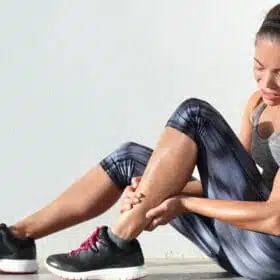Your pants are no longer as tight as they used to be. You get compliments on your athletic arms. You suddenly see muscles that you didn't know existed, but when you step on the scales you realize that your weight hasn't changed at all. Why is that? Quite simply, the reason is the change in your body composition due to the reduction of fat and the build-up of muscle. However, this also means that neither the BMI nor the scales are the ideal tools for female athletes to track their physical development. Not least due to the fact that muscles are heavier than fat, the Body Mass Index, for example, often results in misjudgments that classify athletic women as overweight per se. It is therefore obvious that you need another effective tool to track your progress that also takes into account the physiological differences between muscle and fat tissue. In our Body fat guide to find out how best to approach the matter.
The problem with the body mass index
The simple formula used to calculate the Body Mass Index was developed in the middle of the 19th century and established itself relatively quickly in medicine at the time. Based on body weight and height, doctors at the time also determined the definitions for underweight (BMI < 18.5), normal weight (BMI 18.5-24.9), overweight (BMI 25-30) and the three known obesity categories above a BMI of 30, which are still valid today. For most people of average build, the BMI was then, as it is today, a very useful method for recording physical development and assessing possible health risks. However, particularly active people today benefit just as little from the Body Mass Index as they did back then, because, as already mentioned, it makes no distinction between muscle and fat tissue. According to the BMI definition, an obviously muscular and athletic person like Arnold Schwarzenegger would have a BMI of over 30 and would therefore already be considered obese, which is of course nonsense. Even if the example of Mr. Schwarzenegger is of course very striking, it applies in principle not only to male bodybuilders, but to all people who are active in sport. This was recently confirmed in a study by the American College of Cardiology, in which the scientists found that a large proportion of people with a "normal" BMI have a high body fat percentage. The myth of the BMI as an unmistakable measure was shattered, not least because of this.
Why you should measure your body fat percentage
So to get a realistic assessment of your physical development, it is much better to explicitly measure your body fat percentage rather than subjecting yourself to imprecise calculation methods. It is obvious why you should do this as part of any training program, because this is the only way to determine whether you are building muscle or losing fat. Measuring body fat also has numerous other health benefits. For example, it is very often the case that women who actually have an optimal body weight according to BMI have a significantly increased risk of developing cardiovascular problems. One of the reasons for this is the hormonal environment of the female body, which causes the so-called skinny fat phenomenon. However, this is not a disease, but merely the measurable fact that the body fat percentage is well above average despite a comparatively low weight. In women, this accumulation of body fat is mainly found on the hips, bottom and thighs, which are exactly our problem areas. In medicine, hip circumference in particular is closely linked to health complaints. For example, scientists at a Danish university found that women with a waist circumference of more than 88 centimetres have a significantly higher risk of developing cardiovascular disease than women with a smaller waist. Of course, a look in the mirror will also help you to find out how your body fat percentage is developing. However, you will only be able to monitor this precisely with the help of the right measuring methods. However, before we start measuring your body fat percentage, we would first like to give you a little guide to body fat percentage.
Exemplary body fat percentage:
- Professional female athletes - 15 to 20 percent
- A sporty woman - 21 to 24 percent
- An average healthy woman - 25 to 32 percent
- Overweight: from 33 percent
What is the best way to measure body fat percentage?
There are basically three different methods that can be used to determine body fat percentage. Obviously, however, not all of them are equally suitable for this purpose and also have very individual advantages and disadvantages. The most common method is probably to use a scale that is able to determine the body fat percentage. How accurate this method is, however, depends very much on the quality of the device in question. Inexpensive models in particular, which are mainly used in private households, are prone to errors due to their measuring method, which is why the body fat percentage can deviate by as much as three percent. High-quality devices that deliver precise and consistent results are available from specialist retailers and specific online stores from around 200 euros. The second measuring method, which can also be used at home without any problems, is measuring body fat content using a so-called Calipers. This forceps-like device is used to measure the thickness of the skin folds at different points in order to calculate the body fat percentage from the thickness of the subcutaneous fatty tissue. The more folds are used for the measurement, the more accurate the results will be. However, you should get someone to help you with the procedure in order to obtain precise measurement results, especially in areas of the body that are difficult to reach. Although this procedure involves a little effort, it is the most cost-effective method, as good calipers are available for less than 30 euros. The third and most precise method of measuring body fat percentage is hydrostatic testing. In the course of this hydrostatic measurement, the body fat percentage is determined by placing the person in question in a special pool of water. Based on the water displacement, the body fat percentage is then determined to the nearest tenth of a percent. The disadvantage is obvious, however, as this complex test can understandably only be carried out in suitably equipped institutions. At 15 to 50 euros per test, the costs are also not exactly low.
How you can also assess the change in your body composition in other ways
1 - Notice if your clothes suddenly fit better or start to feel tight on your arms.
2 - Has your performance in training improved? Can you train for longer or can you do more repetitions per set than two weeks ago?
3 - Do you find it easier to do strenuous things in everyday life or is the water tank an insurmountable torture even after several months of training?
4 - Are you generally more energetic and much fitter in the morning?
5 - Look in the mirror.
5 key criteria for healthy fat loss
1. strength training: Strength training not only makes you stronger and leaner, but also increases your metabolic rate. The result - you burn more fat.
2. eat mainly natural foods and eliminate convenience foods from your diet.
Seeds and whole grain products in particular are beneficial for fat loss.
3. don't forget the cardio trainingHigh-intensity interval training (HIIT) is particularly effective at activating your fat metabolism.
4. it is better five to six small meals per day than just two or three large ones.
5. take your time. If you really want to have lasting success in losing fat, you should take things slowly. Crash diets only increase the yo-yo effect.










